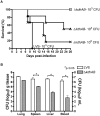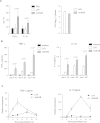Kdo hydrolase is required for Francisella tularensis virulence and evasion of TLR2-mediated innate immunity
- PMID: 23404403
- PMCID: PMC3573668
- DOI: 10.1128/mBio.00638-12
Kdo hydrolase is required for Francisella tularensis virulence and evasion of TLR2-mediated innate immunity
Abstract
The highly virulent Francisella tularensis subsp. tularensis has been classified as a category A bioterrorism agent. A live vaccine strain (LVS) has been developed but remains unlicensed in the United States because of an incomplete understanding of its attenuation. Lipopolysaccharide (LPS) modification is a common strategy employed by bacterial pathogens to avoid innate immunity. A novel modification enzyme has recently been identified in F. tularensis and Helicobacter pylori. This enzyme, a two-component Kdo (3-deoxy-d-manno-octulosonic acid) hydrolase, catalyzes the removal of a side chain Kdo sugar from LPS precursors. The biological significance of this modification has not yet been studied. To address the role of the two-component Kdo hydrolase KdhAB in F. tularensis pathogenesis, a ΔkdhAB deletion mutant was constructed from the LVS strain. In intranasal infection of mice, the ΔkdhAB mutant strain had a 50% lethal dose (LD(50)) 2 log(10) units higher than that of the parental LVS strain. The levels of the proinflammatory cytokines tumor necrosis factor alpha (TNF-α) and interleukin-1β (IL-1β) in bronchoalveolar lavage fluid were significantly higher (2-fold) in mice infected with the ΔkdhAB mutant than in mice infected with LVS. In vitro stimulation of bone marrow-derived macrophages with the ΔkdhAB mutant induced higher levels of TNF-α and IL-1β in a TLR2-dependent manner. In addition, TLR2(-/-) mice were more susceptible than wild-type mice to ΔkdhAB bacterial infection. Finally, immunization of mice with ΔkdhAB bacteria elicited a high level of protection against the highly virulent F. tularensis subsp. tularensis strain Schu S4. These findings suggest an important role for the Francisella Kdo hydrolase system in virulence and offer a novel mutant as a candidate vaccine.
Importance: The first line of defense against a bacterial pathogen is innate immunity, which slows the progress of infection and allows time for adaptive immunity to develop. Some bacterial pathogens, such as Francisella tularensis, suppress the early innate immune response, killing the host before adaptive immunity can mature. To avoid an innate immune response, F. tularensis enzymatically modifies its lipopolysaccharide (LPS). A novel LPS modification-Kdo (3-deoxy-d-manno-octulosonic acid) saccharide removal--has recently been reported in F. tularensis. We found that the kdhAB mutant was significantly attenuated in mice. Additionally, the mutant strain induced an early innate immune response in mice both in vitro and in vivo. Immunization of mice with this mutant provided protection against the highly virulent F. tularensis strain Schu S4. Thus, our study has identified a novel LPS modification important for microbial virulence. A mutant lacking this modification may be used as a live attenuated vaccine against tularemia.
Figures







Similar articles
-
3-Deoxy-D-manno-octulosonic acid (Kdo) hydrolase identified in Francisella tularensis, Helicobacter pylori, and Legionella pneumophila.J Biol Chem. 2010 Nov 5;285(45):34330-6. doi: 10.1074/jbc.M110.166314. Epub 2010 Aug 26. J Biol Chem. 2010. PMID: 20801884 Free PMC article.
-
Impact of Francisella tularensis pilin homologs on pilus formation and virulence.Microb Pathog. 2011 Sep;51(3):110-20. doi: 10.1016/j.micpath.2011.05.001. Epub 2011 May 13. Microb Pathog. 2011. PMID: 21605655 Free PMC article.
-
Contributions of TolC Orthologs to Francisella tularensis Schu S4 Multidrug Resistance, Modulation of Host Cell Responses, and Virulence.Infect Immun. 2019 Mar 25;87(4):e00823-18. doi: 10.1128/IAI.00823-18. Print 2019 Apr. Infect Immun. 2019. PMID: 30670554 Free PMC article.
-
Live Attenuated Tularemia Vaccines for Protection Against Respiratory Challenge With Virulent F. tularensis subsp. tularensis.Front Cell Infect Microbiol. 2018 May 15;8:154. doi: 10.3389/fcimb.2018.00154. eCollection 2018. Front Cell Infect Microbiol. 2018. PMID: 29868510 Free PMC article. Review.
-
Uncovering the components of the Francisella tularensis virulence stealth strategy.Front Cell Infect Microbiol. 2014 Mar 7;4:32. doi: 10.3389/fcimb.2014.00032. eCollection 2014. Front Cell Infect Microbiol. 2014. PMID: 24639953 Free PMC article. Review.
Cited by
-
Francisella tularensis Schu S4 lipopolysaccharide core sugar and O-antigen mutants are attenuated in a mouse model of tularemia.Infect Immun. 2014 Apr;82(4):1523-39. doi: 10.1128/IAI.01640-13. Epub 2014 Jan 22. Infect Immun. 2014. PMID: 24452684 Free PMC article.
-
Pathogenicity and virulence of Francisella tularensis.Virulence. 2023 Dec;14(1):2274638. doi: 10.1080/21505594.2023.2274638. Epub 2023 Nov 8. Virulence. 2023. PMID: 37941380 Free PMC article. Review.
-
Comparative review of Francisella tularensis and Francisella novicida.Front Cell Infect Microbiol. 2014 Mar 13;4:35. doi: 10.3389/fcimb.2014.00035. eCollection 2014. Front Cell Infect Microbiol. 2014. PMID: 24660164 Free PMC article. Review.
-
Functional annotation of conserved hypothetical proteins from Haemophilus influenzae Rd KW20.PLoS One. 2013 Dec 31;8(12):e84263. doi: 10.1371/journal.pone.0084263. eCollection 2013. PLoS One. 2013. PMID: 24391926 Free PMC article.
-
Metabolic Reprogramming of Host Cells by Virulent Francisella tularensis for Optimal Replication and Modulation of Inflammation.J Immunol. 2016 May 15;196(10):4227-36. doi: 10.4049/jimmunol.1502456. Epub 2016 Mar 30. J Immunol. 2016. PMID: 27029588 Free PMC article.
References
-
- Bosio CM, Bielefeldt-Ohmann H, Belisle JT. 2007. Active suppression of the pulmonary immune response by Francisella tularensis Schu4. J. Immunol. 178:4538–4547 - PubMed
-
- Mares CA, Ojeda SS, Morris EG, Li Q, Teale JM. 2008. Initial delay in the immune response to Francisella tularensis is followed by hypercytokinemia characteristic of severe sepsis and correlating with upregulation and release of damage-associated molecular patterns. Infect. Immun. 76:3001–3010 - PMC - PubMed
Publication types
MeSH terms
Substances
Grants and funding
LinkOut - more resources
Full Text Sources
Other Literature Sources
Research Materials

